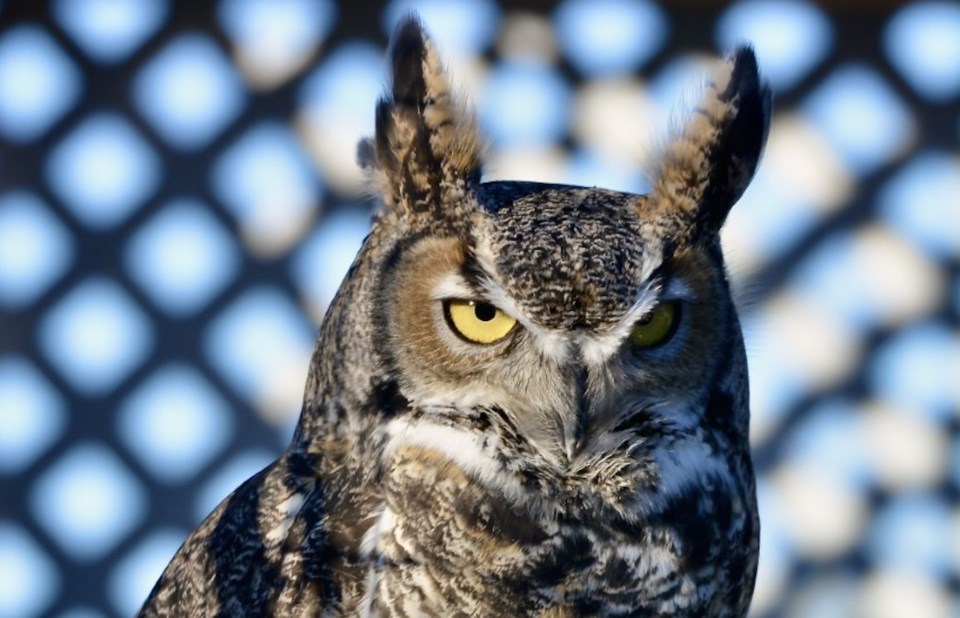T’is the season – for an abundance of owls at the Alberta Institute for Wildlife Conservation (AIWC).
According to AIWC executive director Holly Lillie, the Madden-based animal hospital and rehabilitation centre in Rocky View County has admitted 12 owls in the last month alone. She said while the institute is typically busiest in the spring and summer, the hospital receives injured and orphaned wildlife year-round, and the early winter is a common time to received injured birds of prey – particularly owls.
“This time of year is quite common for seeing birds of prey, such as owls,” she said. “There are quite a few owl species that do remain in Alberta year-round, so we want to get the message out about them and [for people] to be mindful of them, especially as the days are shorter now. It’s not unheard of to see owls in winter and it can actually be easier to see owls in the winter.”
She added owls are usually admitted to AIWC after suffering traumatic head or wing injuries, often the result of unintended conflict with humans.
“A lot of times, what we’re seeing now are owls coming into care who have been hit by cars,” she said, adding AIWC's veterinarians recently conducted a surgical procedure on an owl that had to have an eye removed. Fortunately, she said the operation was a success and added owls, unlike other birds of prey, can still thrive in the wild with just one eye, due to their unique hunting style.
The financial cost and level of care an owl requires at AIWC depends on multiple factors, such as its size, breed, and how severe its injuries are.
Lillie said the most common owl admitted to AIWC is the great horned owl, though the centre also has a few northern saw-whet owls on hand.
She added larger owls typically eat more than smaller owls. For example, great horned owls – the most common owl in Alberta – can eat upwards of eight mice a day.
“We’ve seen a lot more great grey owls than we have typically this year, and we don’t know why that is,” she said. “A lot of times, wildlife populations will spike if there’s a good food source, so they may have more young that year. There are a lot of animals that correlate their populations with the food sources available.”
Though owls and other birds of prey are not the most expensive animals that AIWC cares for, Lillie said they still require plenty of funds to rehabilitate. She said at $1.25 a mouse, it can cost upward of $70 a week to keep great horned owls fed. And if they are at AIWC, it usually means they have to recuperate from an injury and “moult” their feathers, which can take some owls up to two years.
According to Lillie, it can cost AIWC anywhere from $100 to well over $1,000 to care for an individual owl.
“The more work we do, the more food they need, the more antibiotics they need and the length of care, too, [means] they can really become quite expensive,” she said. “We have two great horned owls in care right now that will be with us until next summer, and they actually came into our care in 2020. They both came at a different time, and received some significant feather damage – one from a methane flare and one from a piece of farming equipment.”
“Obviously, that’s very expensive when you’re looking at $15 a day to care for them.”
To help offset the costs of caring for the centre’s many owls – as well as the other injured animals in AIWC’s care – Lillie said the non-profit society is trying to promote its annual Christmastime fundraiser. Give the Gift of Saving Wildlife, as the campaign is known, aims to raise $85,000 by the end of the calendar year to help support the institute’s mission of rehabilitating injured and orphaned wildlife.
With just a few more weeks left in this year’s campaign, Lillie noted there’s still plenty of fundraising to do.
“We’re looking for support from the community, so any support people are able to give – whether it’s $1, $5, or more – really does have a huge impact,” she said. “We’re not funded by the government, so we’re reliant on grants that are successful and then donations.”



